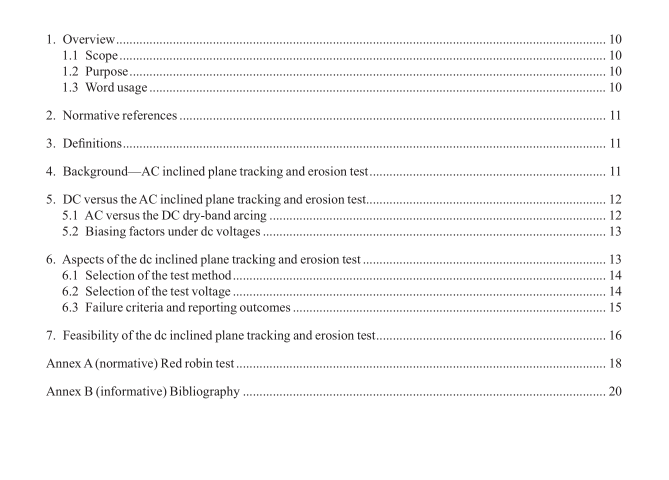IEEE 2652-2021 pdf download.IEEE Guide for DC Inclined Plane Tracking and Erosion Test for Outdoor Insulaton Applicatons
5. DC versus the AC inclined plane tracking and erosion test
5.1 AC versus the DC dry-band arcing Three stages can be identified for the characteristics of the dry-band arcing during the inclined plane tracking and erosion test. The first stage starts with the application of voltage, initiating a scattered dry-band arcing, which usually lasts for a relatively short time. Observing a continuous dry-band close to the bottom electrode marks the second stage.
During this stage, the dry-band arcing causes gradual damage as a result of surface decomposition. The third stage features a remarkably stable dry-band arcing causing significant surface damage such as deep erosion or quickly progressive tracks, eventually a likely failure of the sample under test if the material under test cannot withstand such conditions imposed. Generally, the dry-band arcing produced under dc voltages has been shown to cause more severe surface damage as compared to the standard ac voltages. This difference in surface damage could be attributed to the corresponding intrinsic differences in the voltage waveforms, leading to different dry-band arcing characteristics. For example, the dry-band arcing has been shown to have smaller lengths under dc, which enhances the intensity of the impinged heat degrading the surface. This reduction in length also reduces the resistance of the dry-band arcing plasma, giving rise to higher dry-band arcing current and thus higher power dissipation on the surface.
Depending on the surface condition, the dry-band arcing characteristics may be altered. For example, organic surface residue could promote the surfaces to catch fre (Mathes and McGowan [B5]). Inorganic residue constructs for a stable dry-band arcing, which causes deep erosion (Cherney, et al. [B2]). It has been reported that dc—as compared to ac voltages—causes a signifcant residue formation that leads to a more stable dry- band arcing, particularly under the positive polarity of dc voltages (Cherney, et al. [B2]).
5.2 Biasing factors under dc voltages Other influential factors that are related to the test conditions and not intrinsic to the difference in the dry-band arcing characteristics, may bias the outcomes of the test under dc voltages. These factors along with the need for further mitigating measures are discussed herewith.
5.2.1 Electrowetting During the initial stages of the test and prior to the dry-band formation, the applied voltage causes electrostatic forces at the interface between the liquid-contaminant and the tested surface. With high voltages applied, these electrostatic forces overcome capillary forces, causing the expulsion of the droplets from the contaminant rivulet. This expulsion, which has been shown to be dependent on the voltage type and polarity, reduces the volume of the contaminant rivulet, thus its conductance (Cherney, et al. [B2]). Since the magnitude of the dry- band arcing current and thus the impinged power on the surface is limited by the conductance of the liquid- contaminant, electrowetting of the liquid-contaminant has a consequent biasing effect on the severity of the dry-band arcing on the tested surface depending on the voltage type and polarity. Therefore, the level of the applied voltages needs to be modified as discussed in 6.2 in order to help ensure that such a biasing effect is eliminated.
5.2.2 Polarity efect Generally, it is recommended to use new electrodes with each new ac test; therefore, it is valid to have the same recommendation applied for the dc test. Extensive corrosion has been reported for the upper electrode under positive polarity of dc voltages, and remarkable oxidation was reported for the bottom electrode. However, experimental studies have not reported electrode corrosion or oxidation as a governing factor altering the outcomes of the inclined plane tracking and erosion test (Ghunem, Jayaram, and Cherney [B3]), thus this effect has not been considered in the development of effective dc voltage levels for the test (Cherney, et al. [B2]). Further investigation on this effect is useful in order to confirm whether or not this corrosion has a significant biasing effect on the inclined plane tracking and erosion test outcomes under dc voltages (Cherney, et al. [B2]).IEEE 2652 pdf download.IEEE 2652-2021 pdf download
IEEE 2652-2021 pdf download

Leave a Reply